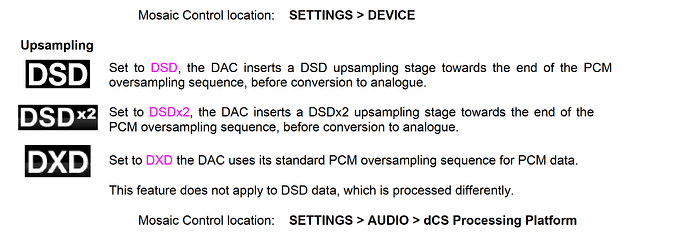PCM is Pulse Code Modulation and it means that the analog signal is measured at some fixed rate – the sample frequency (e.g. 192,000 samples per second) – and each measurement has some bit depth (usually 16 or 24 bits).
CDs are 16bit / 44,100 Hz so the analog signal level was measured (or reproduced) based on 16 bit samples that were taken every 1/44,100th of a second.
DXD is a shorthand for high-rate / high-depth PCM and it corresponds to either 24 / 352,800 or 24 / 384,000. The reason for two rates is that most audio processing is done at rates that are multiples of either 44,100 or 48,000 (and the history / reasoning behind that is a long, long story).
DXD isn’t an upsampling method, it’s just a short and easy way of saying, “24 / 352,800 or 24 / 384,000.”
DSD is a different format that is based on a completely different approach to sampling theory. In it samples are taken at a very high rate – 2,800,000 Hz – but each sample only has one bit of resolution. Furthermore where each PCM sample represents the actual amplitude of the signal at that point in time, DSD is really only able to tell if the amplitude was increasing or decreasing relative to the prior sample. The very high sample rate makes it possible to reconstruct an analog signal using this method. DSD is roughly equivalent in available resolution to 24 / 176,400. DSDx2 doubles the sample rate and is effectively equivalent in available resolution to 24 / 384,000.
The three options in the Rossini mean that incoming PCM data is treated in one of three ways.
- Upsampled to DSD (1 bit / 2,800,000 samples per second) and then processed by the Ring DAC
- Upsampled to DSDx2 (double-rate DSD or 1 bit / 5,600,000 samples per second) and then processed by the Ring DAC
- Upsampled to DXD (either 24 / 352,800 or 24 / 384,000 depending on the incoming sample rate) and then processed by the Ring DAC.
Incoming DSD or DSDx2 is not upsampled and is passed straight through to the Ring DAC.
The end result is the DAC itself being fed by a very high-rate stream which makes it possible for subsequent processing to be done in such a way that filtering happens well outside the audible band.
The differences are subtle and there’s no one “best” method. If there were then you wouldn’t be presented with a choice as we would have already made it for you. Furthermore, the differences are more reliant on how your brain interprets sound via your ears so it’s impossible for me to tell you what you are going to hear.
The frustrating advice here is that you need to listen to the various options and decide your own preference. Some people are very sensitive to different types of acoustic anomalies (phase, time, distortion, etc) and some systems / rooms will amplify those effects. Those people tend to be very sensitive to the various upsampling, mapping, and filter settings and in many cases those preferences change with the incoming sample rate. Other people don’t have that burden prefer a number of different combinations (and in many cases the defaults).
The short of it is that there is no way for me to tell you what you should hear nor what the best combination of settings is. It would be equivalent to me saying that green is the best color and you having a strong preference for red. There’s no reason why one or the other is better nor why there should be a preference, yet we have a strongly-rooted difference of opinion. That difference can be related back to the individual structure of our eyes, neurochemistry, our environment, and conditioning. There’s no universal right answer, but we each have a preference for what feels right.
My advice to you is to avoid trying to A / B different settings and instead listen to yourself. Start with the defaults and get used to the way it sounds. After some time (days) change the upsampling setting and then see how you react to it. Not immediately, but over time. If you find yourself enjoying it more and listening longer then you’re likely on the right path. If you’re losing interest then try a different setting and see what happens. Over time you’ll zero in on the “best” setting(s) (for you) because you’ll no longer have the desire to mess with it and instead just want to enjoy it.

 I only just read the past posts on this thread, there’s tones of info from Andrew!
I only just read the past posts on this thread, there’s tones of info from Andrew!